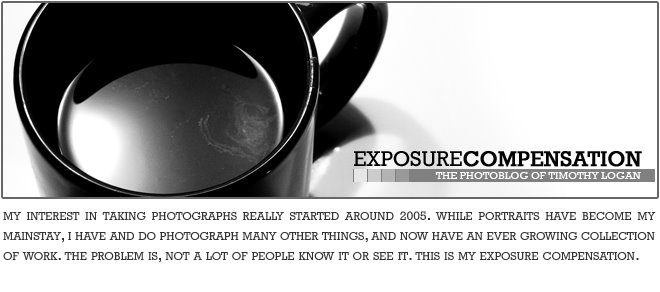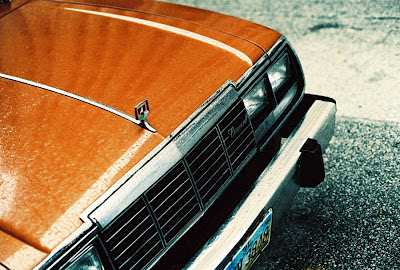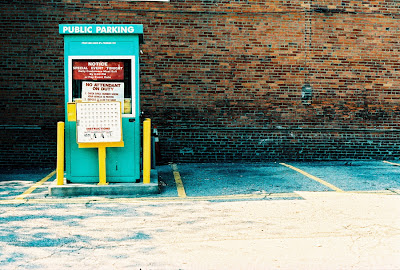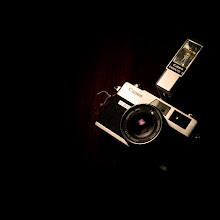31 July 2012
Impossible Project PX680 Test Film V4B - Opacification Returns
Being an Impossible Pioneer means that every so often I am lucky enough to have the opportunity to test new Impossible Project film batches before their mass release to the general public. The batch that I was most recently able to get my hands on contains what I think might be the most exciting news from the Impossible Project since their very first release of a viable instant integral film product - the return of an effective opacification layer.
If you are not overly familiar with instant films, Polaroid, or, the Impossible Project you might be thinking... "huh?" Well, in short, one of the most highly criticized aspects of the Impossible films has been their extreme sensitivity to light immediately out of camera, a problem the original Polaroids solved with a chemical layer called an opacification layer. Basically, the opacification layer was one that shielded the image from light upon ejecting from the camera and then later faded into and remained a clear substance that no longer had any bearing on the appearance of the image. When Impossible took over the reigns of instant film industry many of the chemical components required to make the film just weren't available anymore. Including, as you may have guessed, one of the main ingredients used to create the opacification layer. Well... Naysayers beware, you are about to change your tune.
Once again the Impossible factory team has done the impossible and created an entirely new opacification system that they are claiming to be as strong as the original Polaroid material. Now, for the first time, you can shoot without worrying about shielding your images as they eject from the camera. No more special shades, extra long frog tongues, boxes hanging off the front of your camera, or, even shooting with your camera upside-down... just aim, shoot and enjoy instant film they way it was meant to be enjoyed.
Now, I think it is important to first note when looking at these photos that this is a production batch focused on opacification. This film has not been optimized for color and shouldn't be judged on that alone. What it should be judge on is it's exposure and ability to hold a decent tonal range despite the fact that these images were in no way shielded as they ejected from the camera. In my opinion, considering where Impossible started, these photos show ground breaking evidence in the development of their product and this is exactly the breakthrough the company needed to sway the masses who doubted the product based on it's difficulty to shoot.
Both of these images were shot using an SX-70 with an ND filter. The lighten/darken wheel was pushed one notch towards darken. The images were exposed to direct light out of camera. The first image was shot outside in full sun and after a few seconds dropped into my camera bag to develop as it's still not wise to leave the image in direct sunlight throughout the development process. The second image was shot indoors with available light (which explains the handheld blur) and left out to develop face-up. Both images, I think, turned out quite well.
If I had to make a complaint about this film - and really that is a stretch considering the breakthroughs we're talking about in a product that has been around but two years - it would have to be the development time of this film. I've timed the full development process on this film to be about 30 minutes, which, is probably the longest of all the Impossible films. Really, the time itself doesn't effect me as much as how well the opacification layer blocks the image and my ability to see if I've gotten a proper exposure. The opacification layer itself turns a very dark blue (almost black) that seems to last anywhere from 15-20 minutes before it begins to fade. With earlier versions of the Impossible films I got used to checking exposure throughout the development process and was able to tell very early on if I over or underexposed my image. Now... I generally can't tell until it's likely I've already left the scene of the image.
Again, and I can't say this enough, that is such a minor complaint and a problem that I will happily deal with as the trade off for not having to shield my images anymore. I'm very excited about this film and can't wait to see what Impossible is able to come up with next.
More from this batch coming soon.
26 July 2012
Impossible Project PX70 NIGO - Polar Bear
With all of the 35mm photos I've been showing lately I figured it's high time I post something from the Impossible Project. Today's photo, shot with an SX-70 sonar using Impossible's PX 70 NIGO and an ND pack filter, comes from the Cleveland Metroparks Zoo. I've only been to the Cleveland Zoo once before, but, this past weekend we had the opportunity to go and spend the entire day there.
Camera's in tow, I was hoping to snap quite a few shots throughout the day, but, most of the animals seemed to have different plans as they hid out at the farthest point from all onlookers - generally, somewhere shady on a hot summer's day. That is, until we met this guy - whom I figured would be the most unlikely animal at the Zoo to be laid out sunbathing on a rock. Still, for about ten minutes, he perched there almost as if posing for the crowd like it was his civic duty as an active member of the zoo.
This may have ended up being my only shot of the day, but, I think it made for a good one.
Labels:
Analog Photography,
cleveland ohio,
film photography,
Impossible Project,
Instant film,
NIGO,
polar bear,
PX70,
SX70,
zoo
25 July 2012
35mm Rollei Retro 100 - Canon FTb - Coney Island Part 2
Simply stated, this is a continuation of yesterday's post finishing out my Coney Island images with the Canon FTb and Rollei Retro 100 film. Be sure to check out Part 1 if you haven't already. Enjoy.
24 July 2012
35mm Rollei Retro 100 - Canon FTb - Coney Island Part 1
You might remember back in May that I went to New York for a couple of days for some business meetings, and, that while I was there I got the chance to go to one of my favorite places - Coney Island. I've already posted a couple rounds of photos from that trip through Coney (here and here) but I think this round is actually my favorite. I don't like to post too many photos at the same time, so, I've decided to break this post into two days worth of photos.
All of today and tomorrow's photos come from my Canon FTb and a roll of 35mm Rollei Retro 100 that I picked up in New York at the Lomography store. Rollei is most definitely one of my favorite 35mm black and white films that I've shot with to date and previously the Rollei Retro 400s 120 version of this film gave me some of my favorite medium format film images (the Trikes and Edgewater at Night). I'm now very tempted to buy some of Rollei's 4x5 sheet film to see how it compares.
That's about all for today's post, but, be sure to check back tomorrow for the other half of the Coney Island images that I'll be posting at that time.
Part 2.
23 July 2012
35mm Rollei Retro 100 - Canon FTb - Samantha
Back in June I posted a couple of photos of my brothers kids after they were in town for a visit. As I mentioned then, the youngest, Samantha, didn't get her photo posted because I didn't attempt to photograph her with my Crown Graphic as I figured it'd be nearly impossible to get her to sit still long enough. I did, however, snap a couple shots of her with my 35mm Canon FTb using some Rollei Retro 100 that I had loaded up from my earlier trip to New York. I'm in the process of scanning, resizing and saving all of those images now. So, in the meantime, I figured I would quickly share one of my favorite image of Samantha. Enjoy.
Labels:
100,
35mm,
Analog Photography,
Black and white,
Canon FTb,
family,
Film,
photography,
Rollei Retro
Location:
Cleveland, OH, USA
20 July 2012
Expired Polaroid Type 57 - Graflex Crown Graphic
You might remember, some time ago, that I mentioned purchasing two boxes of expired Polaroid Type 57. Well... it's taken just about a month, but, I finally have an image to show for it. Above is what I would consider my first successful shot on this 09 expired Polaroid Type 57 4x5 sheet film. By my calculations, this is the eighth attempt with this film - which to me just means I have 32 more good shots left in me.
Initially I thought the problem with this film was bad chemistry. Luckily, during Cleveland's Analog Pulse event, we did a large format walk with none other than Mat Marrash - a great large format photographer and co-host of the Film Photography Project's bi-monthly podcast. When Mat found out I was having trouble with my 57 he became determined to figure out why. What he found was that my film didn't appear to have any issues at all, but, it was in fact my Polaroid 545 back that was broken. Despite his best efforts, and many attempts at taking the back apart and reassembling, I eventually had to pick up another 545 off of Ebay.
All of that brings me to this week, and, up until this point I had probably wasted four sheets of film in learning that my film back was in fact never working. From there it only took one gross over-exposure, one bad pod with uneven chemistry, and then one gross under-exposure to eventually come up with this - Sheet number eight and my first successful (read useable) photo using this film.
It's not the best shot in the world, but I'm pretty happy to find this film in working order. There's definitely some grain and despite it's 3000 iso rating I'd venture to guess that it is actually closer to 2000 speed these days. Still, I'm shooting original large format Polaroid film. For a guy who really didn't even get a start in any analog photography until after the closing of the last polaroid factory... I'd say that's pretty cool.
Labels:
4x5,
Analog Photography,
Crown Graphic,
expired film,
Film,
Graflex,
Instant film,
Large format,
Polaroid,
Type 57
Location:
Cleveland, OH, USA
11 July 2012
Ilford Delta 3200 Pro 120 - Yashica D - Huntington Reservation at Night
Back in March I posted a very similar photo to the one above from the Huntington Reservation in the Cleveland Metro parks. That same night, I had my Yashica D along as well - loaded up with some Ilford Delta 3200 Pro - and that is what I used to snap this shot. As you can see, there's definitely a bit more contrast and range in this film than the Fuji instant film and I think I like this shot just a little bit better. This photo was taken shortly after sunset, in nearly complete dark, with a longer exposure. Personally, I love these long exposures by the water - there's something ethereal about the stillness they create...
Labels:
Analog Photography,
delta 3200,
Film,
Huntington,
ilford,
Long exposure,
night photography,
Yashica D
09 July 2012
Fuji Astia Xpro - Canon FTb - Analog's Pulse Cleveland Ohio
As many of you are aware last weekend was the very first Analog's Pulse - an all analog, film loving gathering that happened right here in downtown Cleveland Ohio. The even was a big collaboration hosted and sponsored by some of film photography's finest - Aperture Photography and Variety of Cleveland, Film Photography Project out of New Jersey, A&A Studio's from Chicago, and of course Old-School Photo Lab in New Hampshire.
Held over three days Analog's pulse gave everyone in attendance a chance to meet and greet in person with everyone they communicate with on Twitter and Flickr on a daily basis. There was an opening reception Friday night at Aperture, Street Photography, Instant and Cross process walks on Saturday, and finally a small large format walk on sunday. In between, people gathered, ate, drank and generally had a good time. The event was a huge success and pulled in some great photographers from all over Ohio, New Hampshire, DC, Milwaukee, Toronto and New Jersey.
Of the photowalk's, one of the most popular was definitely the Instant walk which offered first, second and third place prizes for the best photos (including a beautifully refurbished SX70 donated by Leslie Lazenby of Imagine That in Findley Ohio). But, one of the most unique walks was probably the Xpro walk sponsored by Old School Photo Lab and A&A Studio's. A&A donated a bunch of Fuji Astia slide film which everyone shot during the Xpro walk and then Jake from Old School Photo Lab took it all back to NH with him, cross processed it and posted individual galleries online for all the participants. The results have been popping up on Flickr, Twitter and Blogs every since. It's been great to see the results so quickly considering it was an analog event.
The photos posted below are my own favorites from the Xpro walk that I shot with my Canon FTb using a 55mm f/1.2 lens. This was my first experience with cross processing, but, I definitely think there are some good shots from the roll.
And, if you're interested in seeing more, here are some other blogs of note that I'm aware of boasting images from this great event (if you have a post as well please let me know so that I can update this list for everyone)
Posts by - Jen Langman, John Meadows, Dave Lam, Jason Benning, and of course a full Flickr Gallery
Now, without further ado, my own Xpro:
Held over three days Analog's pulse gave everyone in attendance a chance to meet and greet in person with everyone they communicate with on Twitter and Flickr on a daily basis. There was an opening reception Friday night at Aperture, Street Photography, Instant and Cross process walks on Saturday, and finally a small large format walk on sunday. In between, people gathered, ate, drank and generally had a good time. The event was a huge success and pulled in some great photographers from all over Ohio, New Hampshire, DC, Milwaukee, Toronto and New Jersey.
Of the photowalk's, one of the most popular was definitely the Instant walk which offered first, second and third place prizes for the best photos (including a beautifully refurbished SX70 donated by Leslie Lazenby of Imagine That in Findley Ohio). But, one of the most unique walks was probably the Xpro walk sponsored by Old School Photo Lab and A&A Studio's. A&A donated a bunch of Fuji Astia slide film which everyone shot during the Xpro walk and then Jake from Old School Photo Lab took it all back to NH with him, cross processed it and posted individual galleries online for all the participants. The results have been popping up on Flickr, Twitter and Blogs every since. It's been great to see the results so quickly considering it was an analog event.
The photos posted below are my own favorites from the Xpro walk that I shot with my Canon FTb using a 55mm f/1.2 lens. This was my first experience with cross processing, but, I definitely think there are some good shots from the roll.
And, if you're interested in seeing more, here are some other blogs of note that I'm aware of boasting images from this great event (if you have a post as well please let me know so that I can update this list for everyone)
Posts by - Jen Langman, John Meadows, Dave Lam, Jason Benning, and of course a full Flickr Gallery
Now, without further ado, my own Xpro:
06 July 2012
Impossible Project PX70 NIGO - Texaco
It's been a couple of posts since I've put up any Impossible Project scans - a rarity for this blog. Today though, I have a shot using the Impossible Project PX70 NIGO film that I shot with my Polaroid SX-70 Sonar. I took this photo yesterday while in the tiny little town of West Middlesex Pennsylvania. Before heading back to Cleveland after a fun fourth of July back in my hometown we took a little detour over the PA border to stop in a couple different antique stores and flea markets. While I didn't find anything great, I did come across this Texaco sign which made for a nice quick photo.
Also, I got an email yesterday that my cross processed film from the Analog Pulse event here in Cleveland has been finished and posted to an online gallery - at first glance they look great, and, I will be going through them soon and choosing favorites to post up here on the blog. Stay tuned!
Labels:
Analog Photography,
Film,
Impossible Project,
Instant film,
NIGO,
Pennsylvania,
Polaroid,
PX70,
SX70,
Texaco
Location:
West Middlesex, PA, USA
03 July 2012
Kodak Elite Chrome 200 Expired - Canon FTb - NYC and Brooklyn
 |
| Flat Iron Building |
Not really a whole lot to say about this post, but, as I mentioned in this earlier post, I have a few images to share from a roll of expired Elite Chrome 200 slide film that I ran through my Canon FTb with a 55mm f/1.2. This is probably the quickest that I have ever gone through a roll of 35mm film (shooting an entire roll in a few hours) but I'm working on using this format a bit more. I don't know why, but this is a format I've often avoided to a degree - perhaps just because I take forever to finish a roll, which of course, means it takes forever to get to see the images. Whatever the case may be, there will be some more 35mm in the near future including some Rollei Retro 100 from around Coney Island and some Fuji Astia that was taken this past weekend during Analog's Pulse that is being cross processed by Old School PhotoLab in New Hampshire as we speak.
But, for now, here are the remainder of the Kodak images from New York City and the Park Slope area of Brooklyn. Enjoy.
 |
| Cab outside Center for Alternative Photography |
 |
| Basketball Courts in Park Slope Brooklyn |
 |
| Traffic Signal - East 30th St |
 |
| Store Front in Greenwich Village |
 |
| Street Vendor on Broadway |
 |
| View from the Impossible Project NYC Space |
Labels:
35mm,
Analog Photography,
Brooklyn NY,
Canon FTb,
Color,
expired film,
flat iron,
kodak,
kodak elite chrome 200,
nyc,
photography,
slide film,
Street Photography
Location:
New York, NY, USA
Subscribe to:
Comments (Atom)




































